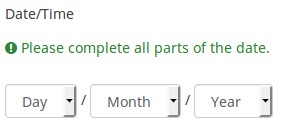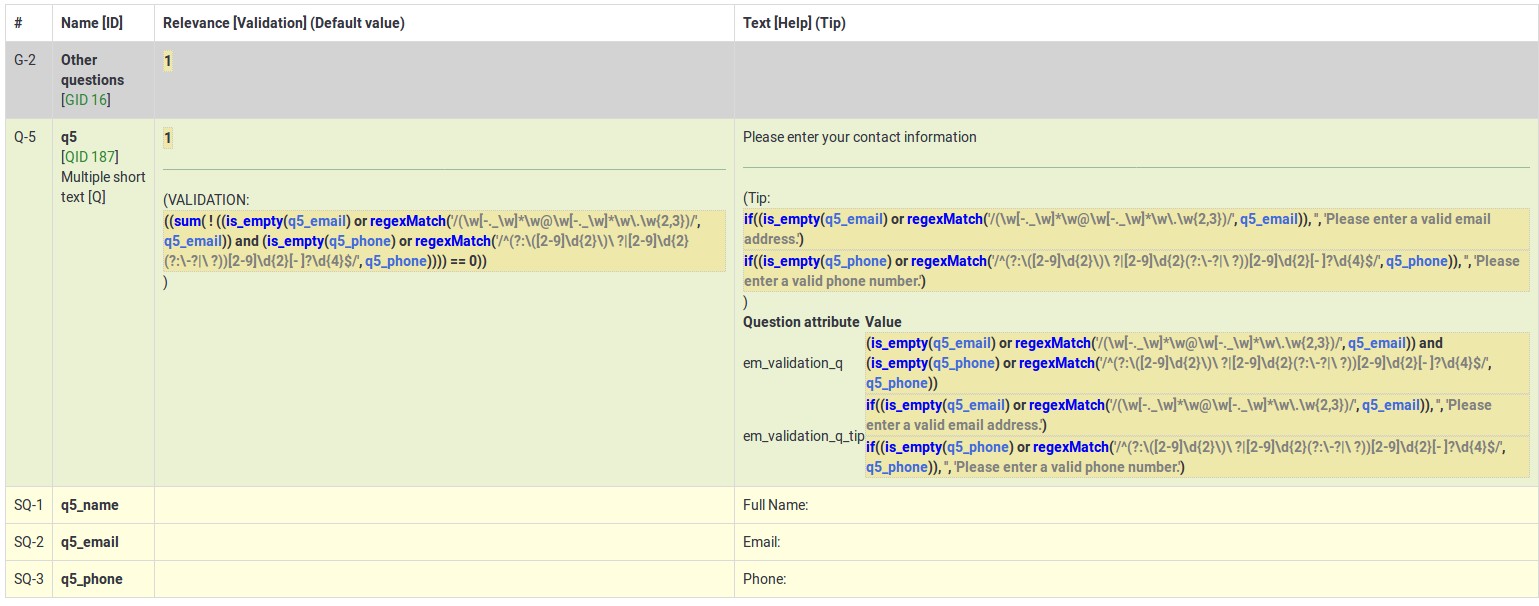Question type - Date/sl: Difference between revisions
From LimeSurvey Manual
No edit summary |
(Created page with "{{QS:Obvezno}}") |
||
| Line 12: | Line 12: | ||
=Glavne nastavitve= | =Glavne nastavitve= | ||
{{QS: | {{QS:Obvezno}} | ||
{{QS:defaults}} | {{QS:defaults}} | ||
Revision as of 01:23, 13 August 2013
Kratek opis
To vrsto vprašanja lahko uporabimo, če želimo vprašati po določenem datumu, ki ga lahko direktno vnesemo s pomočjo JavaScript koledarja ali z uporabo spustnega menija. Od verzije 1.80 dalje je možno določiti minimalno in maksimalno vrednost, ki je navedena v spustnem meniju.
Glavne nastavitve
Condition (previously "Relevance equation")
Description
If the result value of the condition is "1" or "true", the question is "relevant" in the survey context, i.e. it is shown to the survey participant. If not, the question is hidden. Any survey question allows you to specify a relevance equation. This function is the successor of conditions and supports much more complex conditional logic.
Syntax Highlighting
Whenever you save the condition, it is evaluated and syntax-highlighted. Any errors will be color coded so that you can quickly detect and fix them.

Valid values
- Any condition that makes use of the ExpressionScript syntax, without surrounding curly braces.
Examples
Here are good examples of syntax highlighting.
Advanced settings
Reverse answer order (reverse)
Description
If activated, the order of the answers will be reversed.
Available options
- On
- Off (default)
Example
Let's assume that you want to use an Array (Numbers) question type. If this option is disabled (default value), then the possible answers a survey participant can select are: "1, 2, 3, ... , 10". If enabled, the setting will reverse the order of the available answers: "10, 9, 8, ... , 1".
Randomization group name (random_group)
Description
It places the questions into a specified randomization group, all questions included in the specified group being displayed in a random order to the survey respondents.
You can find a sample survey using randomization group name in ExpressionScript sample survey.
Valid values
Just enter any string you like (for example: 'group1'). All question which have set the same string within the randomization group name box will have their place in the survey randomized (=randomly exchanged among each other).
Preview
To preview the questions use the preview survey instead of the preview question group function, as the second has been reported to not show the questions in a randomized order.
Display dropdown boxes (dropdown_dates)
Description
If enabled, the date/time question type will display a dropdown box to the respondents from where to choose the date/time, instead of the default popup.
Available options
- On
- Off (default)
Example
If it is turned on, the question will be displayed in the following way:

Description
If enabled, the question will always be hidden - it will not be displayed to the survey participants. This function can be used in the following scenarios:
- If you wish to prefill a question with a URL and you want not to have it displayed on the screen. This overrides any conditions used within the survey because the respective question will not even be embedded on the page.
- If you wish to store or calculate a value on the fly via the ExpressionScript - Presentation.
Available options
- On
- Off (default)
Minimum year (dropdown_dates_year_min)
Description
This question attribute can be used to set the minimum year value for the calendar question. It applies to the dropdown- and to the popup-variant of the calendar.
Valid values
Any year value
Maximum year (dropdown_dates_year_max)
Description
This question attribute can be used to set the maximum year value for the calendar question. It applies to the dropdown- and to the popup-variant of the calendar.
Valid values
Any year value
Question validation equation (em_validation_q)
Description
This is an equation that is used to validate the entire question (e.g, all of its parts collectively for a multi-answer question). If the question fails the validation criteria, then em_validation_q_tip message will be displayed (it uses the CSS style .error). This tip uses the .em_q_fn_validation CSS style, which is hidden by default within template.css.
The main difference between this feature and the subquestion validation equations (em_validation_sq option) is that for this feature, if the question (or question parts) fail validation, then an error message could be shown. For the subquestion validation, each text entry cell (e.g., in an array question type, but it can also be applied to single entry question types) will be styled so that the background color is (light) red.
Valid values
- Any equation that makes use of the ExpressionScript syntax, without surrounding curly braces.
Example
- You want to collect demographic information from users via a multiple short text question, and you want to validate that the user has entered a valid email address and phone number.
This example shows how the question looks with invalid answers:

And here is what it looks like with one invalid answer:

Here is how you edit a question to enter that information:

And here is part of the Show Logic File output that lets you check the accuracy of your expression and ensure that there are no syntax errors:

As you can see, the validation equation tests that both the email and phone number are either empty or match a regular expression filter.
The validation tip only shows the warning message if the phone or email appears invalid.

If you wish to import the example from above into your LimeSurvey installation, download the following .lsq file: Em_validation_q_example.zip.

Validation on date
Tip for whole question validation equation (em_validation_q_tip)
Description
If you are using the question validation equation, you can use this box in order to display an optional message as question tip on how the question has to be filled out.
Valid values
- Any string or equation that makes use of the ExpressionScript syntax.
Example
See the example from the question validation equation wiki section- it shows how the tip can be tailored to show which parts of a multiple short text question fail the validation criteria.
Insert page break in printable view (page_break)
Description
This attribute is only active when you actually print a survey from the Printable View. It forces a page break before the question.
Available options
- On
- Off (default)